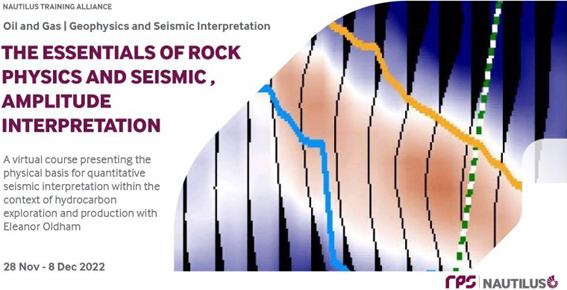
Date: 28th Nov - 8th Dec 2022
Start Time: 14:00 GMT
Location: Virtual
Instructors: Eleanor Oldham, Rob Simm
The Essentials of Rock Physics and Seismic Amplitude Interpretation course is scheduled from 28 Nov - 8 December with Eleanor Oldham. This is a virtual course ideal for geoscientists, petrophysicists, and reservoir engineers seeking an introduction to practical rock physics application in seismic interpretation. For experienced geophysicists, who are regularly involved in seismic modelling, the course can be used as a refresher.
Business Impact: Rock physics has numerous applications for adding reserves and growing production within the business cycle; from recognition of diagnostic seismic signatures in prospect identification to reservoir characterisation and volumetric uncertainty estimation in field evaluation as well as enhanced oil recovery through time lapse techniques in field development. Moreover, a cross discipline understanding of rock physics is central to the effective integration of geology, petrophysics, geophysics, engineering.
This course presents the physical basis for quantitative seismic interpretation within the context of hydrocarbon exploration and production. Key technologies are explained in a straightforward manner; with topics including rock physics analysis of log data, well ties, 1D and 2D seismic modelling, amplitude and AVO analysis, seismic inversion to rock properties and the use of seismic amplitude information in prospect risking. Practical exercises utilise Excel based applets to aid understanding and the lessons learnt are of general application.
Participants will learn to:
- Make a basic AVO model and use it to determine expectations in seismic interpretation in a variety of AVO scenarios.
- Understand the principal characteristics of seismic wavelets and appreciate how the interference phenomenon can be used in the thickness prediction problem.
- Tie a well using the well seismic matching and adaptive techniques and appreciate the importance of well tie information in the construction of forward models and seismic inversions.
- Understand Gassmann fluid substitution and how rock physics models in general can be used in log conditioning and interpretation.
- Understand different approaches to AVO analysis, how AVO projections work and the importance of data quality in the successful application of AVO analysis.
- Understand bandlimited impedance and how it can be used in an AVO context for interpretation of net pay thickness.
- Appreciate the differences between classical ‘best estimate’ seismic inversion and modern rock physics based techniques such as JiFi and ODiSI.
- Understand the basics of Bayes theorem and how it can be applied in probabilistic approaches to seismic inversion and prospect risking.
KeyFacts Energy Industry Directory: RPS Energy l KeyFacts Energy news: Training
 KEYFACT Energy
KEYFACT Energy